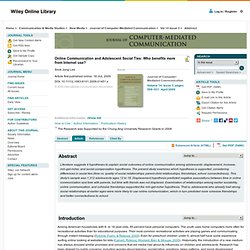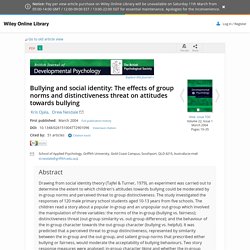

Identity and Self Esteem. Malcolm London: “High School Training Ground” Empowering Adolescents Through Critical Literacy. Sarah-Jayne Blakemore: The mysterious workings of the adolescent brain. Chimamanda Ngozi Adichie: The danger of a single story. Online Communication and Adolescent Social Ties: Who benefits more from Internet use?* - Lee - 2009 - Journal of Computer-Mediated Communication. Abstract Literature suggests 4 hypotheses to explain social outcomes of online communication among adolescents: displacement, increase, rich-get-richer, and social-compensation hypotheses.

The present study examines which hypothesis is supported, considering differences in social ties (time vs. quality of social relationships; parent-child relationships; friendships; school connectedness). This study's sample was 1,312 adolescents ages 12 to 18. Displacement hypothesis predicted negative associations between time in online communication and time with parents, but time with friends was not displaced. Examination of relationships among earlier sociability, online communication, and cohesive friendships supported the rich-get-richer hypothesis. Introduction Among American households with 8- to 18-year-olds, 85 percent have personal computers.
Displacement Hypothesis One of the earlier studies prompting the displacement hypothesis of Internet use and social interaction is Kraut et al.' Summary. Día de los Muertos Is Not Halloween Back in the 1960s, the great essayist Joseph Mitchell wrote about his awe at seeing murals depicting "animated skeletons mimicking living human beings engaged in many kinds of human activities, mimicking them and mocking them....

I was astonished by these pictures. " He was describing, of course, the imagery of Día de los Muertos. In Mitchell's era, the Latin American holiday was exotic and largely unknown to U.S. readers, and he was performing his writerly duty of passing along intriguing cultural information to his audience. Today, we all are familiar with Día de los Muertos -- the white face paint on celebrants, the ubiquitous illustrations of grinning skulls, the small panoramas of skeleton musicians and dancers. However, there is still great confusion in America about what this holiday actually signifies. Día de los Muertos is a time for people to pray for and remember friends and family members who have died. Halloween, in contrast, long ago lost its religious and spiritual roots. Día de los Muertos Is Not Halloween Sociocultural influences on adolescent boys’ body image and body change strategies.
Abstract Society provides messages about how people should ideally look and previous research has indicated these messages, both the actual messages provided and the perception of the message, influence body image.

Research into male body image has shown males are concerned with having a lean and muscular body and as such, may want to decrease fat and increase their muscles. This paper explored the influence of a range of messages from parents, peers, and the media on a number of different measures of 362 adolescent boys’ body image and body change strategies. Specifically, messages about shape, food, exercise, losing weight and increasing muscles were explored in relation to satisfaction with weight and muscles, and the use of strategies to decrease weight and increase muscles. Keywords Adolescent boys; Sociocultural influences; Body image; Body change strategies Choose an option to locate/access this article: Racial/Cultural Identity Development Model. Cultural and Societal Influences on Adolescent Development. How the media affects youth.
News & America's kids: How young people perceive & are impacted by the news. Adolescence: Crash Course Psychology #20. Bullying and social identity: The effects of group norms and distinctiveness threat on attitudes towards bullying - Ojala - 2004 - British Journal of Developmental Psychology. Drawing from social identity theory (Tajfel & Turner, 1979), an experiment was carried out to determine the extent to which children's attitudes towards bullying could be moderated by in-group norms and perceived threat to group distinctiveness.

The study investigated the responses of 120 male primary school students aged 10-13 years from five schools. The children read a story about a popular in-group and an unpopular out-group which involved the manipulation of three variables: the norms of the in-group (bullying vs. fairness); distinctiveness threat (out-group similarity vs. out-group difference); and the behaviour of the in-group character towards the out-group character (bullying vs. helpful). It was predicted that a perceived threat to group distinctiveness, represented by similarity between the in-group and the out-group, and salient group norms that prescribed either bullying or fairness, would moderate the acceptability of bullying behaviours. Identity Crisis/ Identity Formation. Identity Crisis/ Identity Formation.